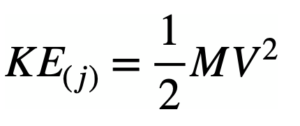Kinetic Energy
At this point, it is helpful to mention the kinetic force that develops during the ship’s turning, which takes on particular importance in escort when the speed is generally higher than 6 knots. If a vessel fast turns to one side, whether voluntary or not, the kinetic force grows until no tug can counter.
The higher the speed, the more efficient the rudder becomes, the kinetic energy grows, and the less power reserve remains for the tug.
Therefore, the reactivity and speed with which the tug in assistance manages to intervene to control an involuntary yawing – before it becomes unmanageable for him – are essential. A tug’s line that is too long, which does not allow rapid movement into the working position, must be an element to be considered.
 Kinetic Energy formula
Kinetic Energy formula
The kinetic energy KE is equal to the Mass, M times the speed, V squared, divided by 2; in other words, the kinetic energy generated by the ship increases to the square of its speed!
If in the open sea, speeds of over 10 knots are acceptable. Eight knots are a limit to which to refer during an escort.
